Human Resource Information System Report: Qantas Airways Case Study
VerifiedAdded on 2023/06/07
|7
|1865
|228
Report
AI Summary
This report provides an analysis of the Human Resource Information System (HRIS) implemented by Qantas Airways to manage its growing workforce and global expansion. The report explores how Qantas Airways utilizes HRIS for critical functions, including recruitment, selection, and training of employees, particularly in anticipation of expanding its flight operations to South America. It details the functionalities of the HRIS, such as database management, applicant tracking, and integration with a Learning Management System (LMS) for training purposes. The report highlights the benefits of using HRIS, such as improved efficiency, reduced costs, and better data management, while also acknowledging potential challenges like security concerns and the need for skilled personnel. The report emphasizes the importance of data integrity, productivity enhancements, and cost-effectiveness in the HRIS design and implementation, particularly focusing on how the system supports the airline's objectives of recruiting and training pilots and crew. The conclusion underscores the significant advantages of the HRIS in improving organizational efficiency and supporting Qantas Airways' expansion goals.
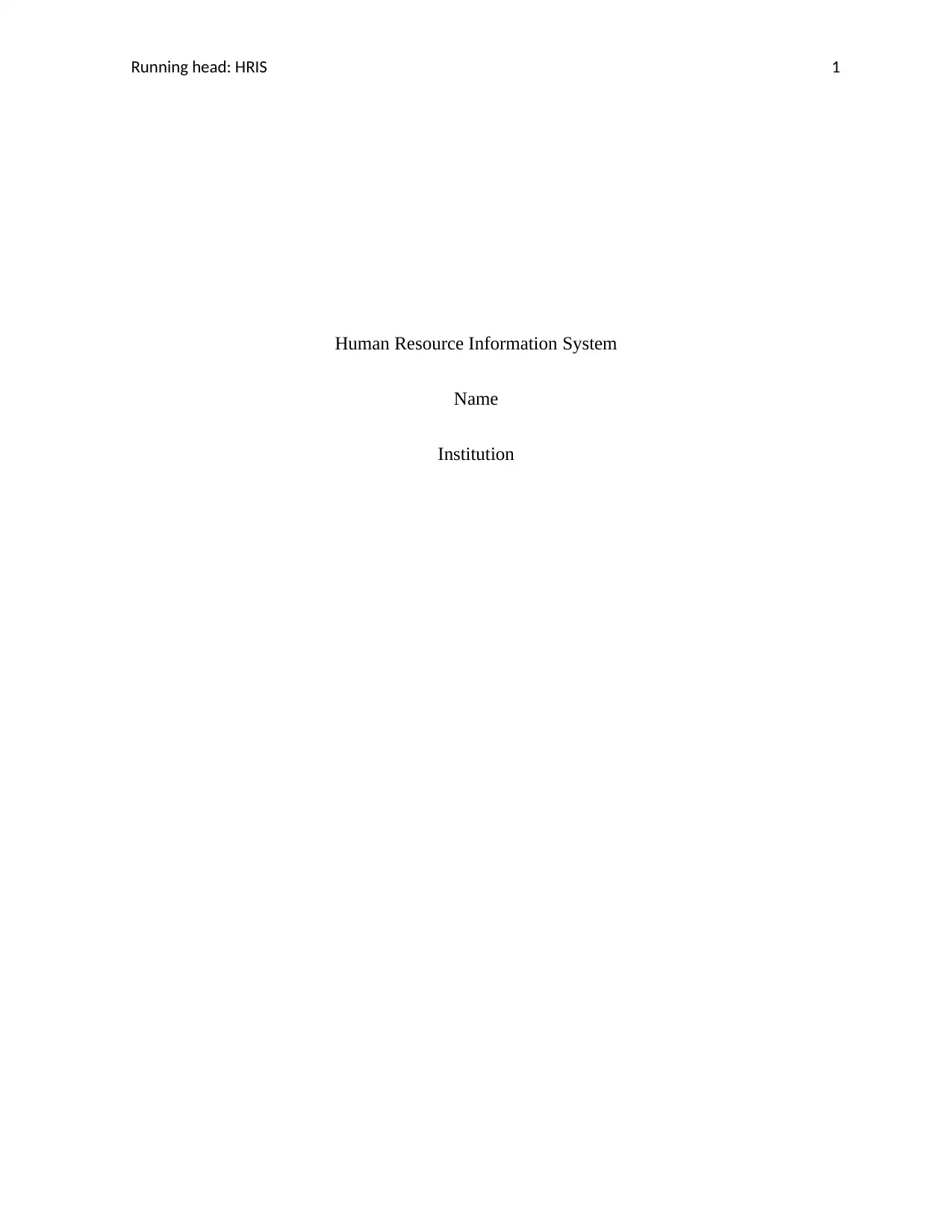
Running head: HRIS 1
Human Resource Information System
Name
Institution
Human Resource Information System
Name
Institution
Paraphrase This Document
Need a fresh take? Get an instant paraphrase of this document with our AI Paraphraser
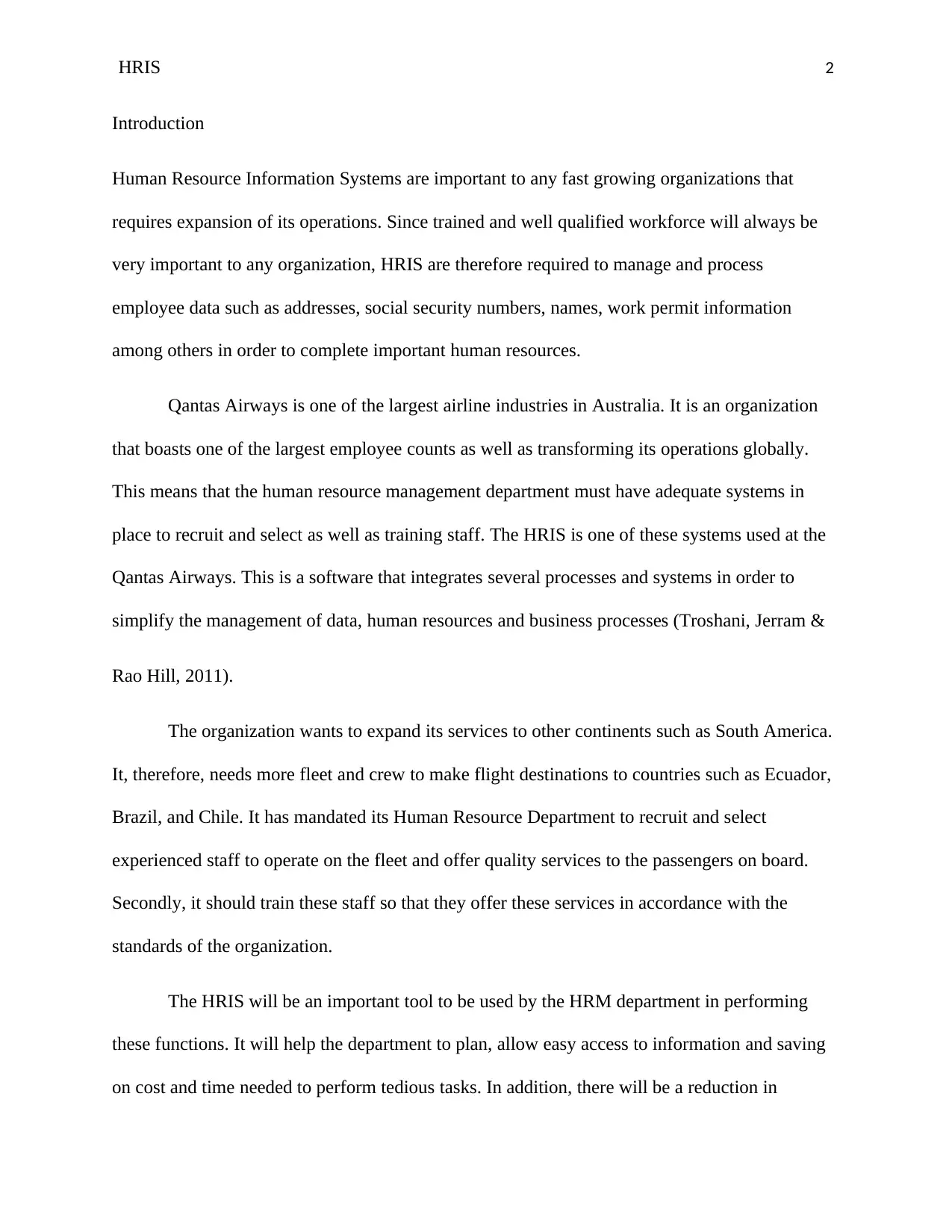
HRIS 2
Introduction
Human Resource Information Systems are important to any fast growing organizations that
requires expansion of its operations. Since trained and well qualified workforce will always be
very important to any organization, HRIS are therefore required to manage and process
employee data such as addresses, social security numbers, names, work permit information
among others in order to complete important human resources.
Qantas Airways is one of the largest airline industries in Australia. It is an organization
that boasts one of the largest employee counts as well as transforming its operations globally.
This means that the human resource management department must have adequate systems in
place to recruit and select as well as training staff. The HRIS is one of these systems used at the
Qantas Airways. This is a software that integrates several processes and systems in order to
simplify the management of data, human resources and business processes (Troshani, Jerram &
Rao Hill, 2011).
The organization wants to expand its services to other continents such as South America.
It, therefore, needs more fleet and crew to make flight destinations to countries such as Ecuador,
Brazil, and Chile. It has mandated its Human Resource Department to recruit and select
experienced staff to operate on the fleet and offer quality services to the passengers on board.
Secondly, it should train these staff so that they offer these services in accordance with the
standards of the organization.
The HRIS will be an important tool to be used by the HRM department in performing
these functions. It will help the department to plan, allow easy access to information and saving
on cost and time needed to perform tedious tasks. In addition, there will be a reduction in
Introduction
Human Resource Information Systems are important to any fast growing organizations that
requires expansion of its operations. Since trained and well qualified workforce will always be
very important to any organization, HRIS are therefore required to manage and process
employee data such as addresses, social security numbers, names, work permit information
among others in order to complete important human resources.
Qantas Airways is one of the largest airline industries in Australia. It is an organization
that boasts one of the largest employee counts as well as transforming its operations globally.
This means that the human resource management department must have adequate systems in
place to recruit and select as well as training staff. The HRIS is one of these systems used at the
Qantas Airways. This is a software that integrates several processes and systems in order to
simplify the management of data, human resources and business processes (Troshani, Jerram &
Rao Hill, 2011).
The organization wants to expand its services to other continents such as South America.
It, therefore, needs more fleet and crew to make flight destinations to countries such as Ecuador,
Brazil, and Chile. It has mandated its Human Resource Department to recruit and select
experienced staff to operate on the fleet and offer quality services to the passengers on board.
Secondly, it should train these staff so that they offer these services in accordance with the
standards of the organization.
The HRIS will be an important tool to be used by the HRM department in performing
these functions. It will help the department to plan, allow easy access to information and saving
on cost and time needed to perform tedious tasks. In addition, there will be a reduction in
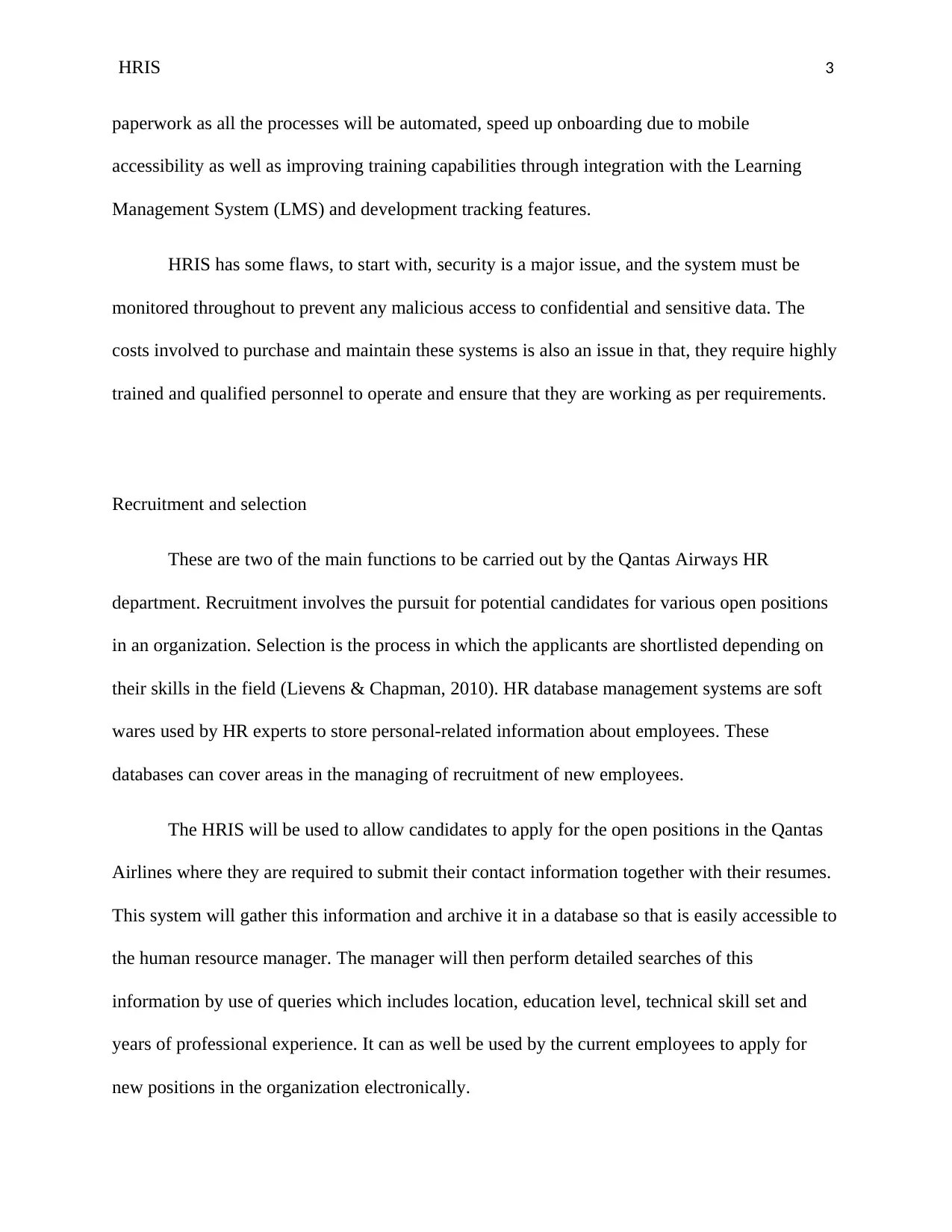
HRIS 3
paperwork as all the processes will be automated, speed up onboarding due to mobile
accessibility as well as improving training capabilities through integration with the Learning
Management System (LMS) and development tracking features.
HRIS has some flaws, to start with, security is a major issue, and the system must be
monitored throughout to prevent any malicious access to confidential and sensitive data. The
costs involved to purchase and maintain these systems is also an issue in that, they require highly
trained and qualified personnel to operate and ensure that they are working as per requirements.
Recruitment and selection
These are two of the main functions to be carried out by the Qantas Airways HR
department. Recruitment involves the pursuit for potential candidates for various open positions
in an organization. Selection is the process in which the applicants are shortlisted depending on
their skills in the field (Lievens & Chapman, 2010). HR database management systems are soft
wares used by HR experts to store personal-related information about employees. These
databases can cover areas in the managing of recruitment of new employees.
The HRIS will be used to allow candidates to apply for the open positions in the Qantas
Airlines where they are required to submit their contact information together with their resumes.
This system will gather this information and archive it in a database so that is easily accessible to
the human resource manager. The manager will then perform detailed searches of this
information by use of queries which includes location, education level, technical skill set and
years of professional experience. It can as well be used by the current employees to apply for
new positions in the organization electronically.
paperwork as all the processes will be automated, speed up onboarding due to mobile
accessibility as well as improving training capabilities through integration with the Learning
Management System (LMS) and development tracking features.
HRIS has some flaws, to start with, security is a major issue, and the system must be
monitored throughout to prevent any malicious access to confidential and sensitive data. The
costs involved to purchase and maintain these systems is also an issue in that, they require highly
trained and qualified personnel to operate and ensure that they are working as per requirements.
Recruitment and selection
These are two of the main functions to be carried out by the Qantas Airways HR
department. Recruitment involves the pursuit for potential candidates for various open positions
in an organization. Selection is the process in which the applicants are shortlisted depending on
their skills in the field (Lievens & Chapman, 2010). HR database management systems are soft
wares used by HR experts to store personal-related information about employees. These
databases can cover areas in the managing of recruitment of new employees.
The HRIS will be used to allow candidates to apply for the open positions in the Qantas
Airlines where they are required to submit their contact information together with their resumes.
This system will gather this information and archive it in a database so that is easily accessible to
the human resource manager. The manager will then perform detailed searches of this
information by use of queries which includes location, education level, technical skill set and
years of professional experience. It can as well be used by the current employees to apply for
new positions in the organization electronically.
⊘ This is a preview!⊘
Do you want full access?
Subscribe today to unlock all pages.

Trusted by 1+ million students worldwide
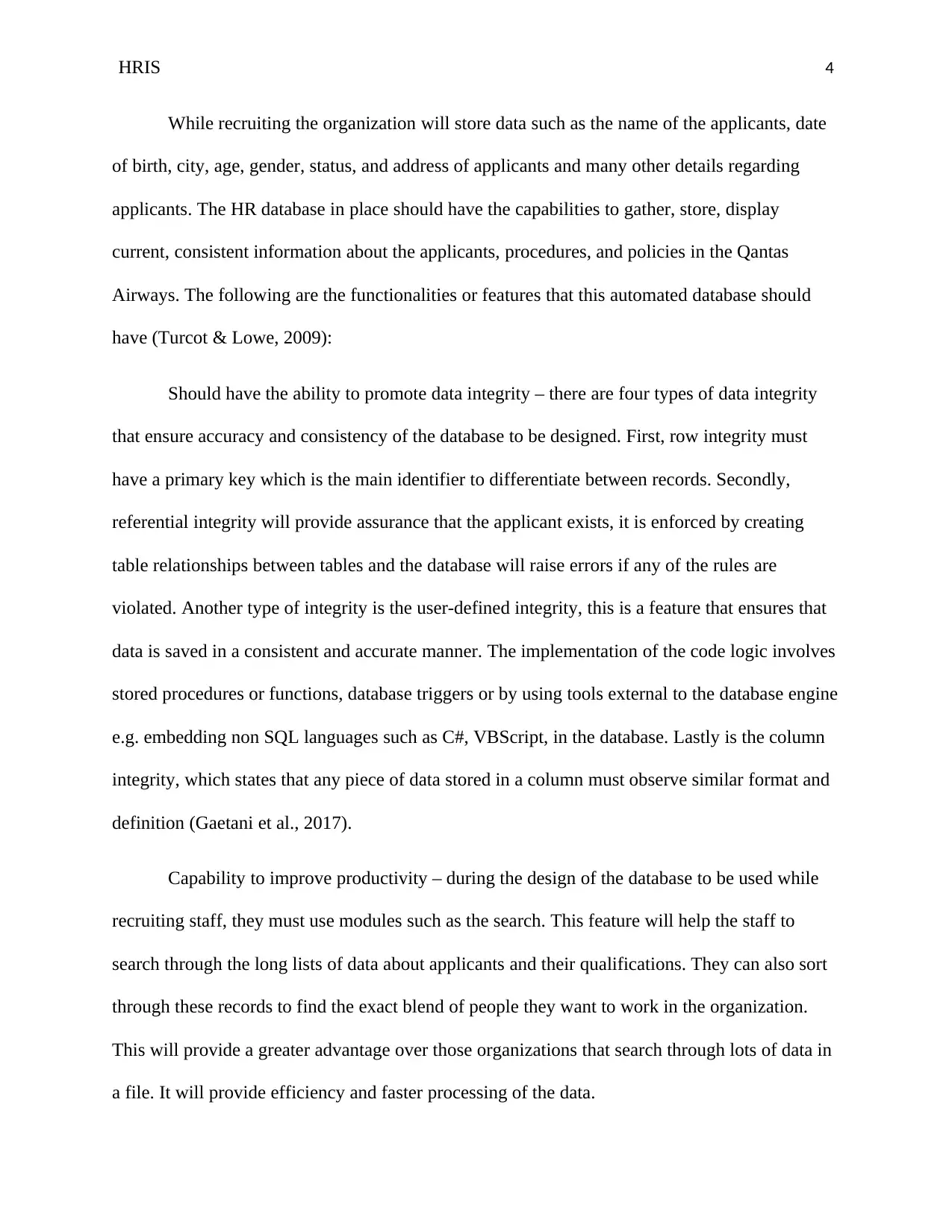
HRIS 4
While recruiting the organization will store data such as the name of the applicants, date
of birth, city, age, gender, status, and address of applicants and many other details regarding
applicants. The HR database in place should have the capabilities to gather, store, display
current, consistent information about the applicants, procedures, and policies in the Qantas
Airways. The following are the functionalities or features that this automated database should
have (Turcot & Lowe, 2009):
Should have the ability to promote data integrity – there are four types of data integrity
that ensure accuracy and consistency of the database to be designed. First, row integrity must
have a primary key which is the main identifier to differentiate between records. Secondly,
referential integrity will provide assurance that the applicant exists, it is enforced by creating
table relationships between tables and the database will raise errors if any of the rules are
violated. Another type of integrity is the user-defined integrity, this is a feature that ensures that
data is saved in a consistent and accurate manner. The implementation of the code logic involves
stored procedures or functions, database triggers or by using tools external to the database engine
e.g. embedding non SQL languages such as C#, VBScript, in the database. Lastly is the column
integrity, which states that any piece of data stored in a column must observe similar format and
definition (Gaetani et al., 2017).
Capability to improve productivity – during the design of the database to be used while
recruiting staff, they must use modules such as the search. This feature will help the staff to
search through the long lists of data about applicants and their qualifications. They can also sort
through these records to find the exact blend of people they want to work in the organization.
This will provide a greater advantage over those organizations that search through lots of data in
a file. It will provide efficiency and faster processing of the data.
While recruiting the organization will store data such as the name of the applicants, date
of birth, city, age, gender, status, and address of applicants and many other details regarding
applicants. The HR database in place should have the capabilities to gather, store, display
current, consistent information about the applicants, procedures, and policies in the Qantas
Airways. The following are the functionalities or features that this automated database should
have (Turcot & Lowe, 2009):
Should have the ability to promote data integrity – there are four types of data integrity
that ensure accuracy and consistency of the database to be designed. First, row integrity must
have a primary key which is the main identifier to differentiate between records. Secondly,
referential integrity will provide assurance that the applicant exists, it is enforced by creating
table relationships between tables and the database will raise errors if any of the rules are
violated. Another type of integrity is the user-defined integrity, this is a feature that ensures that
data is saved in a consistent and accurate manner. The implementation of the code logic involves
stored procedures or functions, database triggers or by using tools external to the database engine
e.g. embedding non SQL languages such as C#, VBScript, in the database. Lastly is the column
integrity, which states that any piece of data stored in a column must observe similar format and
definition (Gaetani et al., 2017).
Capability to improve productivity – during the design of the database to be used while
recruiting staff, they must use modules such as the search. This feature will help the staff to
search through the long lists of data about applicants and their qualifications. They can also sort
through these records to find the exact blend of people they want to work in the organization.
This will provide a greater advantage over those organizations that search through lots of data in
a file. It will provide efficiency and faster processing of the data.
Paraphrase This Document
Need a fresh take? Get an instant paraphrase of this document with our AI Paraphraser
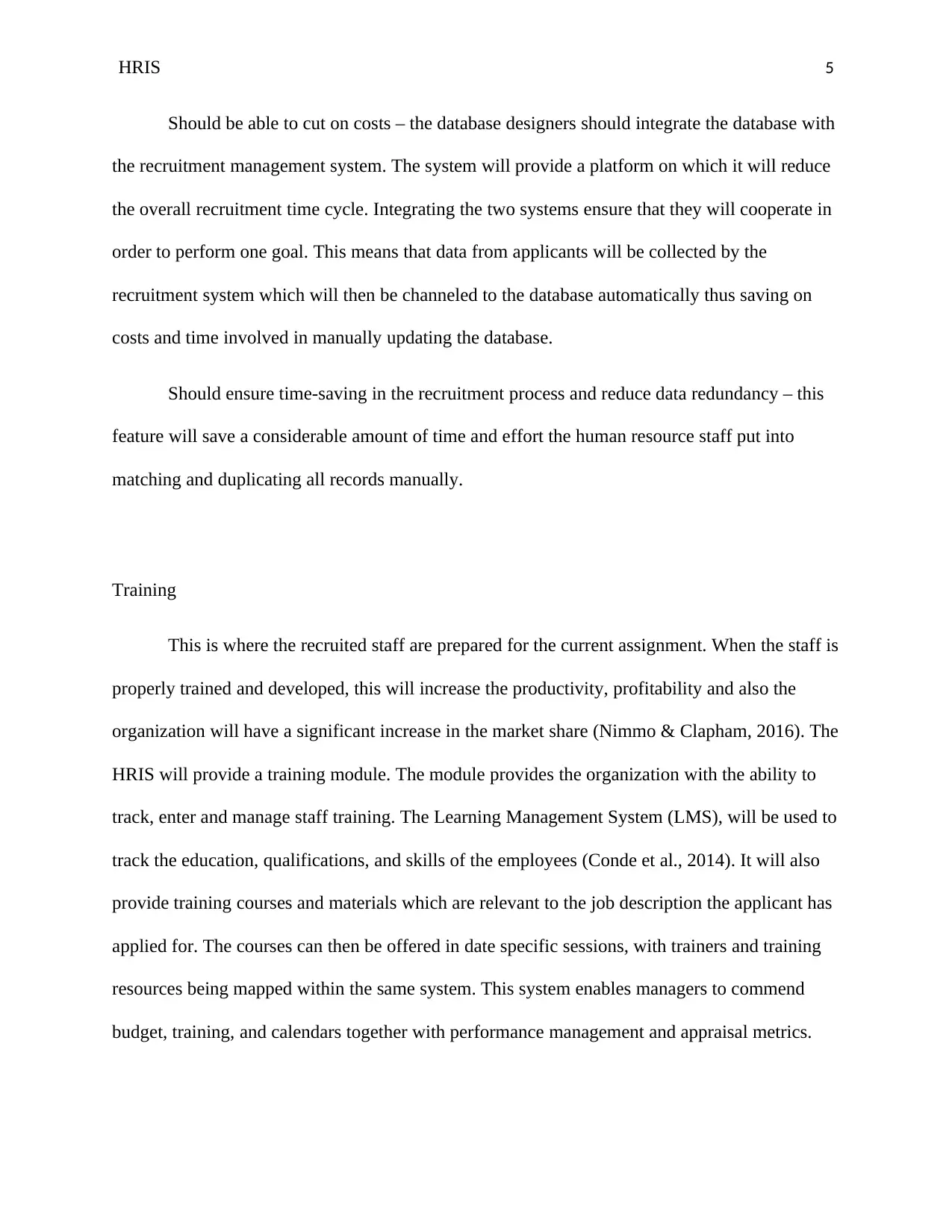
HRIS 5
Should be able to cut on costs – the database designers should integrate the database with
the recruitment management system. The system will provide a platform on which it will reduce
the overall recruitment time cycle. Integrating the two systems ensure that they will cooperate in
order to perform one goal. This means that data from applicants will be collected by the
recruitment system which will then be channeled to the database automatically thus saving on
costs and time involved in manually updating the database.
Should ensure time-saving in the recruitment process and reduce data redundancy – this
feature will save a considerable amount of time and effort the human resource staff put into
matching and duplicating all records manually.
Training
This is where the recruited staff are prepared for the current assignment. When the staff is
properly trained and developed, this will increase the productivity, profitability and also the
organization will have a significant increase in the market share (Nimmo & Clapham, 2016). The
HRIS will provide a training module. The module provides the organization with the ability to
track, enter and manage staff training. The Learning Management System (LMS), will be used to
track the education, qualifications, and skills of the employees (Conde et al., 2014). It will also
provide training courses and materials which are relevant to the job description the applicant has
applied for. The courses can then be offered in date specific sessions, with trainers and training
resources being mapped within the same system. This system enables managers to commend
budget, training, and calendars together with performance management and appraisal metrics.
Should be able to cut on costs – the database designers should integrate the database with
the recruitment management system. The system will provide a platform on which it will reduce
the overall recruitment time cycle. Integrating the two systems ensure that they will cooperate in
order to perform one goal. This means that data from applicants will be collected by the
recruitment system which will then be channeled to the database automatically thus saving on
costs and time involved in manually updating the database.
Should ensure time-saving in the recruitment process and reduce data redundancy – this
feature will save a considerable amount of time and effort the human resource staff put into
matching and duplicating all records manually.
Training
This is where the recruited staff are prepared for the current assignment. When the staff is
properly trained and developed, this will increase the productivity, profitability and also the
organization will have a significant increase in the market share (Nimmo & Clapham, 2016). The
HRIS will provide a training module. The module provides the organization with the ability to
track, enter and manage staff training. The Learning Management System (LMS), will be used to
track the education, qualifications, and skills of the employees (Conde et al., 2014). It will also
provide training courses and materials which are relevant to the job description the applicant has
applied for. The courses can then be offered in date specific sessions, with trainers and training
resources being mapped within the same system. This system enables managers to commend
budget, training, and calendars together with performance management and appraisal metrics.
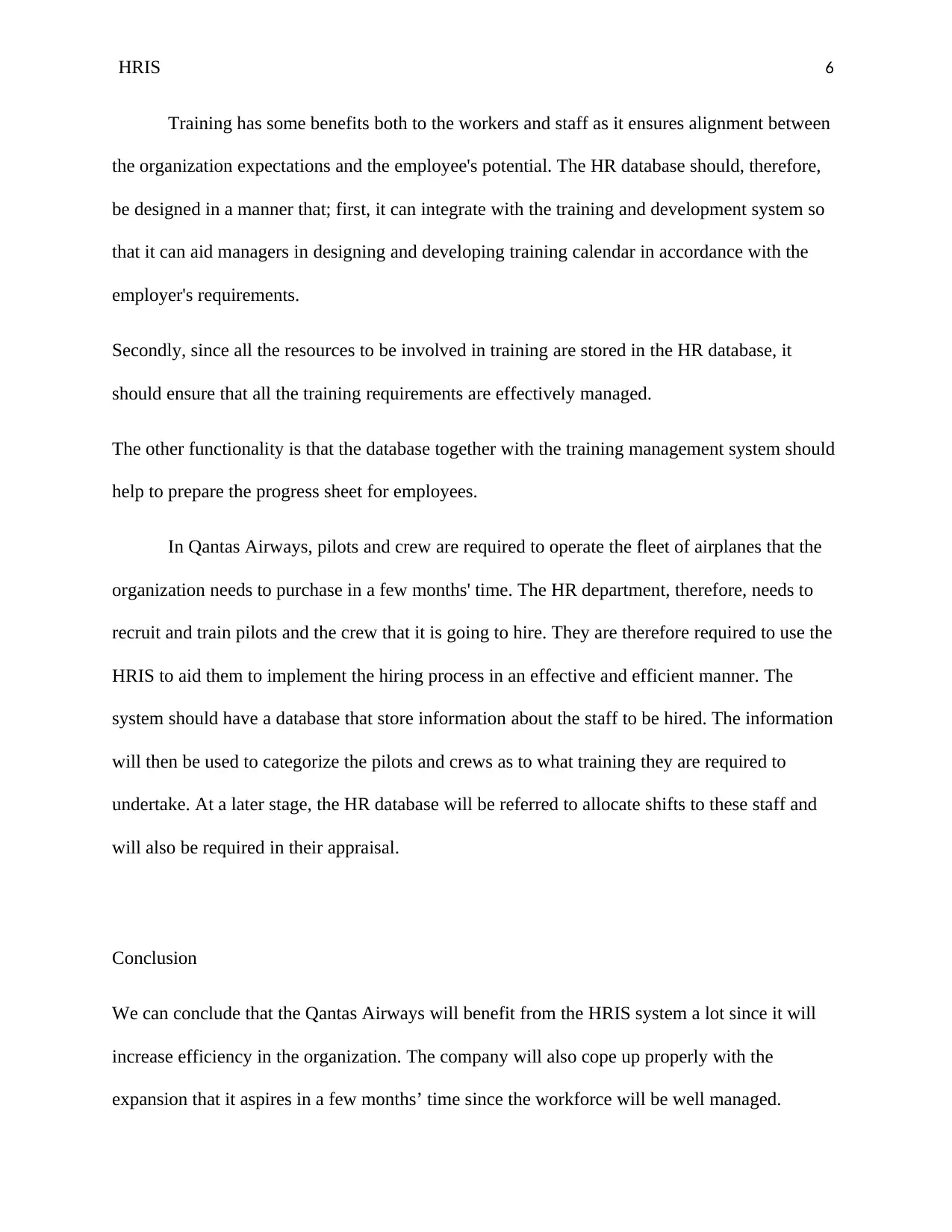
HRIS 6
Training has some benefits both to the workers and staff as it ensures alignment between
the organization expectations and the employee's potential. The HR database should, therefore,
be designed in a manner that; first, it can integrate with the training and development system so
that it can aid managers in designing and developing training calendar in accordance with the
employer's requirements.
Secondly, since all the resources to be involved in training are stored in the HR database, it
should ensure that all the training requirements are effectively managed.
The other functionality is that the database together with the training management system should
help to prepare the progress sheet for employees.
In Qantas Airways, pilots and crew are required to operate the fleet of airplanes that the
organization needs to purchase in a few months' time. The HR department, therefore, needs to
recruit and train pilots and the crew that it is going to hire. They are therefore required to use the
HRIS to aid them to implement the hiring process in an effective and efficient manner. The
system should have a database that store information about the staff to be hired. The information
will then be used to categorize the pilots and crews as to what training they are required to
undertake. At a later stage, the HR database will be referred to allocate shifts to these staff and
will also be required in their appraisal.
Conclusion
We can conclude that the Qantas Airways will benefit from the HRIS system a lot since it will
increase efficiency in the organization. The company will also cope up properly with the
expansion that it aspires in a few months’ time since the workforce will be well managed.
Training has some benefits both to the workers and staff as it ensures alignment between
the organization expectations and the employee's potential. The HR database should, therefore,
be designed in a manner that; first, it can integrate with the training and development system so
that it can aid managers in designing and developing training calendar in accordance with the
employer's requirements.
Secondly, since all the resources to be involved in training are stored in the HR database, it
should ensure that all the training requirements are effectively managed.
The other functionality is that the database together with the training management system should
help to prepare the progress sheet for employees.
In Qantas Airways, pilots and crew are required to operate the fleet of airplanes that the
organization needs to purchase in a few months' time. The HR department, therefore, needs to
recruit and train pilots and the crew that it is going to hire. They are therefore required to use the
HRIS to aid them to implement the hiring process in an effective and efficient manner. The
system should have a database that store information about the staff to be hired. The information
will then be used to categorize the pilots and crews as to what training they are required to
undertake. At a later stage, the HR database will be referred to allocate shifts to these staff and
will also be required in their appraisal.
Conclusion
We can conclude that the Qantas Airways will benefit from the HRIS system a lot since it will
increase efficiency in the organization. The company will also cope up properly with the
expansion that it aspires in a few months’ time since the workforce will be well managed.
⊘ This is a preview!⊘
Do you want full access?
Subscribe today to unlock all pages.

Trusted by 1+ million students worldwide
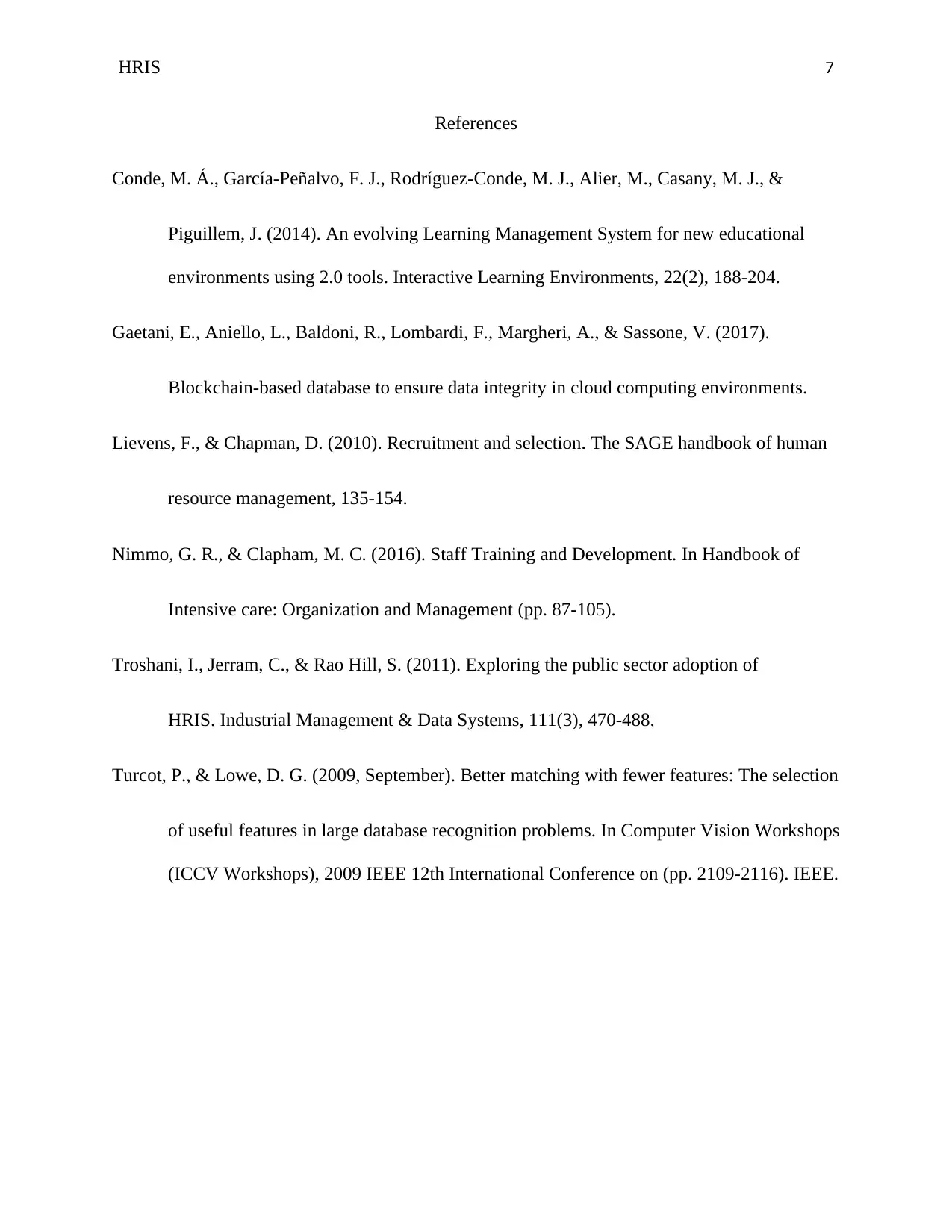
HRIS 7
References
Conde, M. Á., García-Peñalvo, F. J., Rodríguez-Conde, M. J., Alier, M., Casany, M. J., &
Piguillem, J. (2014). An evolving Learning Management System for new educational
environments using 2.0 tools. Interactive Learning Environments, 22(2), 188-204.
Gaetani, E., Aniello, L., Baldoni, R., Lombardi, F., Margheri, A., & Sassone, V. (2017).
Blockchain-based database to ensure data integrity in cloud computing environments.
Lievens, F., & Chapman, D. (2010). Recruitment and selection. The SAGE handbook of human
resource management, 135-154.
Nimmo, G. R., & Clapham, M. C. (2016). Staff Training and Development. In Handbook of
Intensive care: Organization and Management (pp. 87-105).
Troshani, I., Jerram, C., & Rao Hill, S. (2011). Exploring the public sector adoption of
HRIS. Industrial Management & Data Systems, 111(3), 470-488.
Turcot, P., & Lowe, D. G. (2009, September). Better matching with fewer features: The selection
of useful features in large database recognition problems. In Computer Vision Workshops
(ICCV Workshops), 2009 IEEE 12th International Conference on (pp. 2109-2116). IEEE.
References
Conde, M. Á., García-Peñalvo, F. J., Rodríguez-Conde, M. J., Alier, M., Casany, M. J., &
Piguillem, J. (2014). An evolving Learning Management System for new educational
environments using 2.0 tools. Interactive Learning Environments, 22(2), 188-204.
Gaetani, E., Aniello, L., Baldoni, R., Lombardi, F., Margheri, A., & Sassone, V. (2017).
Blockchain-based database to ensure data integrity in cloud computing environments.
Lievens, F., & Chapman, D. (2010). Recruitment and selection. The SAGE handbook of human
resource management, 135-154.
Nimmo, G. R., & Clapham, M. C. (2016). Staff Training and Development. In Handbook of
Intensive care: Organization and Management (pp. 87-105).
Troshani, I., Jerram, C., & Rao Hill, S. (2011). Exploring the public sector adoption of
HRIS. Industrial Management & Data Systems, 111(3), 470-488.
Turcot, P., & Lowe, D. G. (2009, September). Better matching with fewer features: The selection
of useful features in large database recognition problems. In Computer Vision Workshops
(ICCV Workshops), 2009 IEEE 12th International Conference on (pp. 2109-2116). IEEE.
1 out of 7
Related Documents
Your All-in-One AI-Powered Toolkit for Academic Success.
+13062052269
info@desklib.com
Available 24*7 on WhatsApp / Email
![[object Object]](/_next/static/media/star-bottom.7253800d.svg)
Unlock your academic potential
Copyright © 2020–2025 A2Z Services. All Rights Reserved. Developed and managed by ZUCOL.





